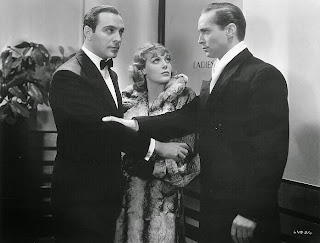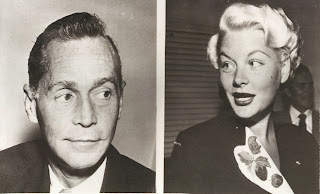Chandler's Marlowe played by Humphrey Bogart, George Montgomery, George Montgomery and Philip Carey (ABC's Philip Marlowe TV Series from 1959 to 1960). At upper left is Humphrey Bogart, wooing Lauren Bacall, as he played Marlowe in the movie "The Big Sleep." At upper right, it's George Montgomery in the role, getting close to Nancy Guild in the "The Brasher Doubloon." At lower left, Robert Montgomery portrays Marlowe, with Audrey Totter at his side in the film "Lady in the Lake." The announcement about the new Walk of Famers doesn't include where their stars will be. But I have a suggestion: in front of Philip Marlowe's office in the Cahuenga Building on Hollywood Boulevard near Ivar. Source: www.latimes.com
Roy Huggins learned to write detective novels by studying Raymond Chandler, even copying in long hand one of his books so that he could get used to the thinking and style. "The Big Sleep" and "Farewell, My Lovely" inspired Huggins' "The Double Take" (1946), featuring Los Angeles private eye Stuart Bailey. In 1950 Roy Huggins moved into an apartment in Beverly Hills following his separation and pending divorce from Bonnie. Shortly after moving in, he embarked on a short-lived relationship with Franchot Tone's former wife Jean Wallace. Huggins was a good friend of Tone and had known Wallace for many years. Huggins was someone to talk over problems with and for a short time he listened.
Huggins wasn't happy when the title "The Double Take" was changed to "I Love Trouble" for the film release. Stuart Biley (Franchot Tone) is hired by wealthy politician Ralph Johnston (Tom Powers) to investigate threatening letters addressing to his wife. Bailey's curiosity is aroused further when Mrs. Johnston's sister Norma (Janet Blair) arrives on the scene and fails to recognize a photograph of Mrs. Johnston as her sister.
When Mrs. Caprillo (Janis Carter) attempts to bribe Bailey to stop probing into the case, Norma recognizes her as her sister Jane. The plot takes another twist when Mrs. Johnston's body is found under a pier and Bailey is framed for her murder. Bailey finally solves the case when he learns of Mr. Johnston's plans to frame him of the murder. The convoluted tale comes to a conclusion with Bailey and Norma planning their marriage. -"Roy Huggins: Creator of Maverick, 77 Sunset Strip, The Fugitive and The Rockford Files" (2014) by Paul Green
Harold B. Hersey, the publisher who created Gangster Magazine, wrote in his memoir, 'Pulp Editor' (1937), that this was the magazine “that enabled me to lose money in that enterprise until the depression wiped out the business.” He had also created Racketeer Stories, Mobs, Gun Molls, and Gangland Stories. Many of these pulps came to an abrupt end as the Roaring Twenties drew to a close. During their brief lives, they had failed to seduce the top writers into working for them, and most of the bylines appearing in their pages are unknown today.
Against one wall was a bench. On this bench sat Trixie Meloy, Adolph Shanz, and Beroni, manager of the Palmetto Club. All three were manacled, one to the other. Shanz was despair personified. Beroni was haggard. Trixie wore a look of contempt for everybody in the room. Kennedy came in, sat down at a desk and played with a pencil. MacBride said, “I have a letter here that I’m going to read. It will interest you, Miss Meloy.” Trixie bit her lip. MacBride read, “ ‘To Captain Stephen MacBride: The man you want is Tony Bonelio. I worked in his club. I was Miss Meloy’s dancing partner. We’d danced before, all over the country. I loved her. I thought she loved me. Maybe she did until Bonelio won her with money. It drove me crazy. I wanted to kill him. But I didn’t. I wanted to win back Trixie’s love. But I knew if she knew I’d done all that, she’d never look at me again. I was crazy about her. I was, but that’s over. I was lying here, dying, and I called her up to come over. She told me to go to hell and croak. I’ve been a fool. I see what she is now. But go easy with her, Captain, anyhow. The only thing she did was to go to the block-party and say she saw a man in a gray suit walking away. She didn’t see anybody. It was just a stall. That’s all she did, except what she did to me. I don’t know, maybe I still love her.’ -"Brother Murder" (1939) by T. T. Flynn
Creamy skin, along with jawdropping beauty, is a frequent motif in these stories, as are gray eyes, most notably in Dashiell Hammett’s “The Girl with the Silver Eyes.” Here, the Continental Op comes face to face with an old nemesis, and marvels at the effect this chameleon has on every man she meets. Some of the lesser pulps, those that paid even less than the standard penny a word, began to feature women in the second decade of the detective pulps, the 1930s, while those that sought an audience with racier material, such as Gun Molls, Saucy Stories, and Spicy Detective, had even more ample reason to feature them.
Tough broads appeared in later pulps, either as out-and-out hoodlums or, more frequently but no less dangerously, as gun molls for their gangster boyfriends. Every significant writer of the pulp era worked for Black Mask, including Paul Cain, Horace McCoy, Frederick L. Nebel, Raoul Whitfield, Erie Stanley Gardner, Charles G. Booth, Roger Torrey, Norbert Davis, George Harmon Coxe, and, of course, the greatest of them all, Raymond Chandler.
Cornell Woolrich (1903-1968) submitted a story titled “Angel Face” to Dime Detective, which published it as “Murder in Wax” in its March 1, 1935, issue. A couple of years later, he sold a similar story about an avenging angel to Black Mask, who published it as “Face Work.” This story has been reprinted often as the title Woolrich clearly wanted for it, “Angel Face,” finally given to it by Frederic Dannay when he reprinted it in Ellery Queen’s Mystery Magazine for December 1946. While it has the usual number of plot inconsistencies one expects from the great poet of darkness, it is quintessential Woolrich in all its noir glory. Both “Face Work” and “Murder in Wax” were the basis for one of the seven great novels in his memorable “Black” series, 'The Black Angel' (1943).
It was bought for the movies soon after publication—the first of numerous Woolrich stories to be filmed. Columbia made it into a weak fifty-eight-minute B movie titled 'Convicted' in 1938. Although it starred a young Rita Hayworth and meticulously followed the story, even lifting much of the original dialogue, it is neither a noir film nor a memorable one. Twelve years later, it was aired as “Angel Face” on radio’s famous Suspense series (May 18, 1950) with Claire Trevor as the good-hearted stripper who tries to save her brother from being convicted of a murder.
She was cuddled against me so that I could feel the vibrancy of her slender, exquisite form. I hugged her against me so tightly that her breasts flattened on my chest, but she strained even harder….
Breathless, she pushed away. She said, “Now that you’ve got me here, what are you going to do with me? I don’t dare go home.” “What about a hotel?”“You haven’t even thought of inviting me to stay here?” I grinned. “It’s okay with me. It ought to be safe enough.” When I turned back from the bureau, she was seated on the edge of the bed, peeling off her stockings. The picture was tempting, but I forced myself to think of my job. I should be reporting at the office. I picked up my topcoat. Polly slipped out of her torn dress. While she got into the pajama jacket, I fought to keep from sweeping her into my arms. All that saved her, I think, was her atmosphere of utter helplessness. She said, “You’re being awfully decent. And me, I’m just a gangster’s girl! Funny, isn’t it?” “Before you go,” she said, “I’d like to tell you that, in spite of what they all said, I never really was Dick Tobin’s sweetheart. None of Russo’s crowd ever actually touched me.” She was a little wistful, and I don’t think she really expected me to believe her. Curiously, I did, and my heart was strangely light as I fitted her key into her door. I gave her my coat and sat patiently while she wiped blood from my face. “Was it worth it—all for a gangster’s girl?” she whispered. I put an arm around her, not caring how much the effort hurt. “I don’t care what kind of girl you are,” I told her. “It was worth it!” -"The Girl Who Knew Too Much" (1941) by Randolph Barr







.jpg)




_15.jpg)



_03.jpg)

.jpg)

_01+(1).jpg)






















.jpg)



















